| Listing 1 - 10 of 58 | << page >> |
Sort by
|
Book
ISBN: 9780080982953 0080982956 9781283868440 128386844X 0080982980 9780080982984 Year: 2013 Publisher: Oxford, UK Waltham, MA Elsevier Butterworth-Heinemann
Abstract | Keywords | Export | Availability | Bookmark
 Loading...
Loading...Choose an application
- Reference Manager
- EndNote
- RefWorks (Direct export to RefWorks)
The second edition of An Introduction to Credit Derivatives provides a broad introduction to products and a marketplace that have changed significantly since the financial crisis of 2008. Author Moorad Choudhry gives a practitioner's perspective on credit derivative instruments and the risks they involve in a succinct style without sacrificing technical details and scientific precision. Beginning with foundational discussions of credit risk, credit risk transfer and credit ratings, the book proceeds to examine credit default swaps and related pricing, asset swaps, credit-link
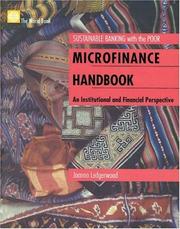
ISBN: 0821343068 9786612657351 0821384317 1282657356 9780821343067 Year: 1999 Publisher: Washington, D.C. : World Bank,
Abstract | Keywords | Export | Availability | Bookmark
 Loading...
Loading...Choose an application
- Reference Manager
- EndNote
- RefWorks (Direct export to RefWorks)
Microfinance is not simply banking; it is a development tool. It has been estimated that there are 500 million economically active poor people in the world operating microenterprises and small businesses. Most of them do not have access to adequate financial services. The purpose of this Handbook is to bring together in a single source guiding principles and tools that will promote sustainable microfinance and create viable institutions. The Handbook takes a global perspective, drawing on lessons learned from the experiences of microfinance practitioners, donors, and others throughout the worl
336.77 --- 339.96 --- Financial institutions --- Microfinance --- Micro-finance --- Microcredit --- Microenterprise lending --- Microlending --- Financial services industry --- Small business --- Financial intermediaries --- Lending institutions --- Associations, institutions, etc. --- 339.96 Ontwikkelingshulp. Ontwikkelingssamenwerking. Ontwikkelingsproblematiek --- Ontwikkelingshulp. Ontwikkelingssamenwerking. Ontwikkelingsproblematiek --- 336.77 Financiering. Krediet. Kredietverlening. --- Financiering. Krediet. Kredietverlening. --- Finance --- LDC / Developping Countries - Pays En Développement --- 333.714 --- 333.134 --- ambachtskrediet, beroepskrediet en volkskrediet. --- Volksbanken. --- Microfinance. --- Financial institutions. --- Financiering. Krediet. Kredietverlening --- Private finance --- Developing countries --- 338.340 --- Volksbanken --- ambachtskrediet, beroepskrediet en volkskrediet --- Algemene ontwikkeling in de Derde Wereld

ISBN: 0415102790 0415137292 1134775784 1280056827 0203347064 9786610056828 0429230427 9780415102797 9780415137294 9780203347065 9781134775781 9781134775736 9781134775774 1134775776 1587980983 Year: 1996 Publisher: London [England] New York Routledge
Abstract | Keywords | Export | Availability | Bookmark
 Loading...
Loading...Choose an application
- Reference Manager
- EndNote
- RefWorks (Direct export to RefWorks)
This book presents a detailed and surprising history of money from Charlemagne's reform in approximately AD800 to the end of the Silver Wars in 1896.
Credit --- Money --- History. --- Money. Monetary policy --- World history --- 338 <09> --- 336.74 --- 336.77 --- 336.7 <09> --- -Credit --- -AA / International- internationaal --- 331.155 --- 331.152 --- 331.162.4 --- 331.154 --- 331.153 --- Currency unions --- -332.49 --- 336.7 <09> Geschiedenis van het bankwezen --- Geschiedenis van het bankwezen --- 336.77 Financiering. Krediet. Kredietverlening. --- Financiering. Krediet. Kredietverlening. --- 336.74 Geld. Geldwezen. Monetaire sector. --- Geld. Geldwezen. Monetaire sector. --- 338 <09> Economische geschiedenis --- Economische geschiedenis --- Borrowing --- Finance --- Loans --- Currency --- Monetary question --- Money, Primitive --- Specie --- Standard of value --- Exchange --- Value --- Banks and banking --- Coinage --- Currency question --- Gold --- Silver --- Silver question --- Wealth --- History --- Geldwezen in de XIXe eeuw tot 1914. --- Geldwezen in de middeleeuwen. --- Geschiedenis van het krediet. --- XVIIe, XVIIIe eeuw. Fysiocratie. --- XVIe eeuw. Mercantilisme. --- Crédit --- Monnaie --- Histoire --- 332.49 --- AA / International- internationaal --- Geldwezen in de middeleeuwen --- XVIe eeuw. Mercantilisme --- XVIIe, XVIIIe eeuw. Fysiocratie --- Geldwezen in de XIXe eeuw tot 1914 --- Geschiedenis van het krediet --- Geld. Geldwezen. Monetaire sector --- Financiering. Krediet. Kredietverlening --- -Money --- Credit - - History --- Money - History
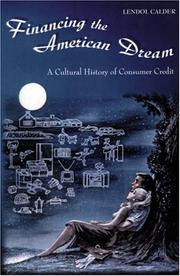
ISBN: 069105827X 0691074550 9786612457821 1400822831 1282457829 1400811171 9781400822836 1400801060 Year: 2009 Publisher: Princeton, NJ
Abstract | Keywords | Export | Availability | Bookmark
 Loading...
Loading...Choose an application
- Reference Manager
- EndNote
- RefWorks (Direct export to RefWorks)
Once there was a golden age of American thrift, when citizens lived sensibly within their means and worked hard to stay out of debt. The growing availability of credit in this century, however, has brought those days to an end--undermining traditional moral virtues such as prudence, diligence, and the delay of gratification while encouraging reckless consumerism. Or so we commonly believe. In this engaging and thought-provoking book, Lendol Calder shows that this conception of the past is in fact a myth. Calder presents the first book-length social and cultural history of the rise of consumer credit in America. He focuses on the years between 1890 and 1940, when the legal, institutional, and moral bases of today's consumer credit were established, and in an epilogue takes the story up to the present. He draws on a wide variety of sources--including personal diaries and letters, government and business records, newspapers, advertisements, movies, and the words of such figures as Benjamin Franklin, Mark Twain, and P. T. Barnum--to show that debt has always been with us. He vigorously challenges the idea that consumer credit has eroded traditional values. Instead, he argues, monthly payments have imposed strict, externally reinforced disciplines on consumers, making the culture of consumption less a playground for hedonists than an extension of what Max Weber called the "iron cage" of disciplined rationality and hard work. Throughout, Calder keeps in clear view the human face of credit relations. He re-creates the Dickensian world of nineteenth-century pawnbrokers, takes us into the dingy backstairs offices of loan sharks, into small-town shops and New York department stores, and explains who resorted to which types of credit and why. He also traces the evolving moral status of consumer credit, showing how it changed from a widespread but morally dubious practice into an almost universal and generally accepted practice by World War II. Combining clear, rigorous arguments with a colorful, narrative style, Financing the American Dream will attract a wide range of academic and general readers and change how we understand one of the most important and overlooked aspects of American social and economic life.
Consumentenrecht --- Consumentisme --- Verenigde Staten --- US / United States of America - USA - Verenigde Staten - Etats Unis --- 339.325.1 --- 331.14 --- 331.162.4 --- 333.72 --- Evolutie van de consumptie. Budget van de huishoudens. --- Geschiedenis van de prijzen, de lonen en de verdeling van de rijkdom. --- Geschiedenis van het krediet. --- Krediet ingedeeld naar de bestemming. Verbruikskrediet --- Verenigde Staten. --- Consumer credit --- Consumption (Economics) --- Consumers --- History. --- Customers (Consumers) --- Shoppers --- Consumer demand --- Consumer spending --- Consumerism --- Spending, Consumer --- Consumer debt --- Persons --- Demand (Economic theory) --- Credit --- United States --- History --- Geschiedenis van de prijzen, de lonen en de verdeling van de rijkdom --- Geschiedenis van het krediet --- Evolutie van de consumptie. Budget van de huishoudens
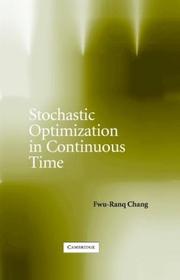
ISBN: 0521834066 0521541948 0511195346 0511196008 0511314353 0511616740 128047792X 0511193947 0511194684 1107149401 9780511193941 9781280477928 9780521834063 9780511196003 9780511194689 9780511195341 9780511616747 9781280477928 9781107149403 9780511314353 9780521541947 Year: 2004 Publisher: Cambridge Cambridge University Press
Abstract | Keywords | Export | Availability | Bookmark
 Loading...
Loading...Choose an application
- Reference Manager
- EndNote
- RefWorks (Direct export to RefWorks)
First published in 2004, this is a rigorous but user-friendly book on the application of stochastic control theory to economics. A distinctive feature of the book is that mathematical concepts are introduced in a language and terminology familiar to graduate students of economics. The standard topics of many mathematics, economics and finance books are illustrated with real examples documented in the economic literature. Moreover, the book emphasises the dos and don'ts of stochastic calculus, cautioning the reader that certain results and intuitions cherished by many economists do not extend to stochastic models. A special chapter (Chapter 5) is devoted to exploring various methods of finding a closed-form representation of the value function of a stochastic control problem, which is essential for ascertaining the optimal policy functions. The book also includes many practice exercises for the reader. Notes and suggested readings are provided at the end of each chapter for more references and possible extensions.
Economics --- Stochastic control theory --- Mathematical models --- AA / International- internationaal --- 305.7 --- Econometrie van het gedrag van de financiële tussenpersonen. Monetaire econometrische modellen. Monetaire agregaten. vraag voor geld. Krediet. Rente. --- Stochastic control theory. --- Mathematical models. --- Business, Economy and Management --- Control theory --- Stochastic processes --- Economics, Mathematical --- Econometrie van het gedrag van de financiële tussenpersonen. Monetaire econometrische modellen. Monetaire agregaten. vraag voor geld. Krediet. Rente --- Economics - Mathematical models
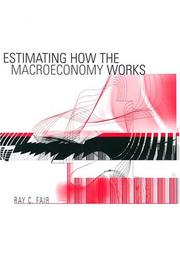
ISBN: 0674015460 0674036638 9780674036635 9780674015463 Year: 2009 Publisher: Cambridge, MA
Abstract | Keywords | Export | Availability | Bookmark
 Loading...
Loading...Choose an application
- Reference Manager
- EndNote
- RefWorks (Direct export to RefWorks)
Macroeconomics tries to describe and explain the economywide movement of prices, output, and unemployment. The field has been sharply divided among various schools, including Keynesian, monetarist, new classical, and others. It has also been split between theorists and empiricists. Ray Fair is a resolute empiricist, developing and refining methods for testing theories and models. The field cannot advance without the discipline of testing how well the models approximate the data. Using a multicountry econometric model, he examines several important questions, including what causes inflation, how monetary authorities behave and what are their stabilization limits, how large is the wealth effect on aggregate consumption, whether European monetary policy has been too restrictive, and how large are the stabilization costs to Europe of adopting the euro. He finds, among other things, little evidence for the rational expectations hypothesis and for the so-called non-accelerating inflation rate of unemployment (NAIRU) hypothesis. He also shows that the U.S. economy in the last half of the 1990s was not a "new age" economy.
Macroeconomics. --- AA / International- internationaal --- 305.95 --- 305.7 --- 303.8 --- Economics --- Econometrie van de lonen en de prijzen (inflatie). --- Econometrie van het gedrag van de financiële tussenpersonen. Monetaire econometrische modellen. Monetaire agregaten. vraag voor geld. Krediet. Rente. --- Econometrische behandeling van een onderwerp. --- Macroeconomics --- Econometrische behandeling van een onderwerp --- Econometrie van het gedrag van de financiële tussenpersonen. Monetaire econometrische modellen. Monetaire agregaten. vraag voor geld. Krediet. Rente --- Econometrie van de lonen en de prijzen (inflatie)
Book
ISBN: 9780199545117 0199545111 Year: 2009 Publisher: Oxford Oxford university
Abstract | Keywords | Export | Availability | Bookmark
 Loading...
Loading...Choose an application
- Reference Manager
- EndNote
- RefWorks (Direct export to RefWorks)
AA / International- internationaal --- 333.130.0 --- 333.139.0 --- 333.109 --- 333.70 --- 657.42 --- Academic collection --- 336.77 --- Credit --- Financial risk management --- 658.88 --- Risk management --- Borrowing --- Finance --- Money --- Loans --- Private banken: algemeen. Studies over de organisatie en de techniek van de banken. --- Controle en nationalisatie van de banken: algemeen. --- Veiligheid. Bankovervallen. Bankrisico's. --- Theorie en organisatie van het bankkrediet. --- Financiële boekhouding van banken en verzekeringen. --- Financiering. Krediet. Kredietverlening. --- Credit. --- Financial risk management. --- Kredietrisicobeheer --- 336.77 Financiering. Krediet. Kredietverlening. --- Kredietrisicobeheer. --- Veiligheid. Bankovervallen. Bankrisico's --- Private banken: algemeen. Studies over de organisatie en de techniek van de banken --- Controle en nationalisatie van de banken: algemeen --- Theorie en organisatie van het bankkrediet --- Financiële boekhouding van banken en verzekeringen --- Financiering. Krediet. Kredietverlening
Book
ISBN: 9780470687253 0470687258 1119206944 9786613240484 1283240483 111999358X 9781119993582 9781119206941 9781119950240 1119950244 Year: 2011 Publisher: Chichester : John Wiley,
Abstract | Keywords | Export | Availability | Bookmark
 Loading...
Loading...Choose an application
- Reference Manager
- EndNote
- RefWorks (Direct export to RefWorks)
""A great write-up on the art of banking. Essential reading for anyone working in finance.""Dan Cunningham, Senior Euro Cash & OBS Dealer, KBC Bank NV, London ""Focused and succinct review of the key issues in bank risk management.""Graeme Wolvaardt, Head of Market Risk Control, Europe Arab Bank plc, London The importance of banks to the world's economic system cannot be overstated. The foundation of consistently successful banking practice remains efficient asset-liability management and liquidity risk management. This book introduces the key concepts of banking,
Private finance --- Banks and banking. --- Bank liquidity --- Asset-liability management. --- Management. --- AA / International- internationaal --- 333.130.0 --- 333.605 --- 333.741.0 --- Private banken: algemeen. Studies over de organisatie en de techniek van de banken --- Nieuwe financiële instrumenten. --- krediet op korte termijn. geldmarkt: Algemeenheden. --- Bank liquidity - Management. --- Bank liquidity -- Management. --- Banks and banking --- Asset-liability management --- Finance --- Business & Economics --- Banking --- Management --- Asset-liability management (Banking) --- Funds management --- Agricultural banks --- Banking industry --- Commercial banks --- Depository institutions --- Financial institutions --- Liquidity (Economics) --- Money --- Investments --- Risk management --- E-books --- Nieuwe financiële instrumenten --- krediet op korte termijn. geldmarkt: Algemeenheden --- Insurance --- Banques --- Gestion du risque
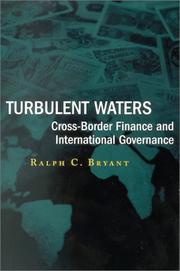
ISBN: 0815700725 0815700717 0815700709 Year: 2003 Publisher: Washington, D.C. : Brookings Institution Press,
Abstract | Keywords | Export | Availability | Bookmark
 Loading...
Loading...Choose an application
- Reference Manager
- EndNote
- RefWorks (Direct export to RefWorks)
Today's world is organized politically into nation states with sovereign national governments. But as Ralph C. Bryant explains in Turbulent Waters, the world's economic structure is outgrowing its political structure. The economic links among nations have increased more rapidly than economic activity itself. As economic integration has proceeded, borders have become more porous, differences among national economies have eroded, and the policy autonomy of national governments has been undermined. Collective-governance problems increasingly spill across national borders and thus grow in importance relative to problems of domestic governance. The evolving need for international cooperation and cross-border collective governance is likely to be the single most prominent feature of world politics and economics for at least the next half century. The progressive integration of the world economy, often called "globalization," has been especially dramatic for financial activity. Cross-border financial transactions facilitate saving and investment and thereby advance the well-being of individuals. But they can also generate turbulence and instability. Most individuals are unsure whether financial globalization promotes or threatens prosperity for a majority of the world's people. Bryant explains basic concepts about financial activity and collective governance, distills their international dimensions, and enables general readers to acquire a solid grasp of the key policy issues that national governments must resolve. He provides fresh insights about what is often termed the international financial architecture. But he also casts his net far wider: the book's ambitious goal is no less than to outline a pragmatically sound vision for the evolution of international governance for the world economy and financial system.
International economic relations --- International finance --- International Monetary Fund --- AA / International- internationaal --- 334.3 --- 333.432.8 --- 333.601 --- Geld-, krediet- en Bankwezen. --- Internationale monetaire organisatie. Internationaal Muntfonds. Algemene leningovereenkomsten. --- Organisatie van de financiële markten. --- Capital movements --- International monetary system --- International money --- Finance --- Capital flight --- Capital flows --- Capital inflow --- Capital outflow --- Flight of capital --- Flow of capital --- Movements of capital --- Balance of payments --- Foreign exchange --- Internationale monetaire organisatie. Internationaal Muntfonds. Algemene leningovereenkomsten --- Organisatie van de financiële markten --- Geld-, krediet- en Bankwezen --- International Monetary Fund. --- Internationaal monetair fonds --- International monetary fund --- IMF. --- International finance. --- Capital movements.

ISBN: 0262026139 9780262026130 0262524937 9786612097003 0262268086 1282097008 1429465530 9780262268080 9781429465533 9781282097001 6612097000 9780262524933 Year: 2007 Publisher: Cambridge, Mass. MIT Press
Abstract | Keywords | Export | Availability | Bookmark
 Loading...
Loading...Choose an application
- Reference Manager
- EndNote
- RefWorks (Direct export to RefWorks)
An important recent advance in macroeconomics is the development of dynamic stochastic general equilibrium (DSGE) macromodels. The use of DSGE models to study monetary policy, however, has led to paradoxical and puzzling results on a number of central monetary issues including price determinacy and liquidity effects. In Money, Interest, and Policy, Jean-Pascal Benassy argues that moving from the standard DSGE models - which he calls "Ricardian" because they have the famous "Ricardian equivalence" property-to another, "non-Ricardian" model would resolve many of these issues. A Ricardian model represents a household as a homogeneous family of infinitely lived individuals, and Benassy demonstrates that a single modification-the assumption that new agents are born over time (which makes the model non-Ricardian)-can bridge the current gap between monetary intuitions and facts, on one hand, and rigorous modeling, on the other.After comparing Ricardian and non-Ricardian models, Benassy introduces a model that synthesizes the two approaches, incorporating both infinite lives and the birth of new agents. Using this model, he considers a number of issues in monetary policy, including liquidity effects, interest rate rules and price determinacy, global determinacy, the Taylor principle, and the fiscal theory of the price level. Finally, using a simple overlapping generations model, he analyzes optimal monetary and fiscal policies, with a special emphasis on optimal interest rate rules.
Money --- Equilibrium (Economics) --- Mathematical models --- AA / International- internationaal --- 305.7 --- 333.80 --- -Equilibrium (Economics) --- -339.53 --- Currency --- Monetary question --- Money, Primitive --- Specie --- Standard of value --- Exchange --- Finance --- Value --- Banks and banking --- Coinage --- Currency question --- Gold --- Silver --- Silver question --- Wealth --- Econometrie van het gedrag van de financiële tussenpersonen. Monetaire econometrische modellen. Monetaire agregaten. vraag voor geld. Krediet. Rente. --- Geld-, bank- en kredietpolitiek. Kapitaalmarkt en -rente: algemeenheden. --- Mathematical models. --- ECONOMICS/Political Economy --- ECONOMICS/Macroeconomics --- 339.53 --- Econometrie van het gedrag van de financiële tussenpersonen. Monetaire econometrische modellen. Monetaire agregaten. vraag voor geld. Krediet. Rente --- Geld-, bank- en kredietpolitiek. Kapitaalmarkt en -rente: algemeenheden --- Money - Mathematical models --- Equilibrium (Economics) - Mathematical models
| Listing 1 - 10 of 58 | << page >> |
Sort by
|

 Search
Search Feedback
Feedback About UniCat
About UniCat  Help
Help News
News